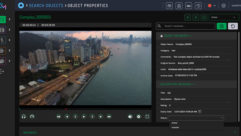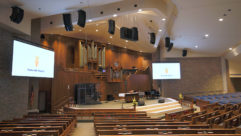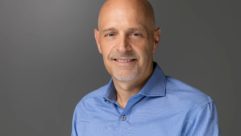
SVC: Tell us about the Cornerstone Church. I know it’s a big place with a 4,700-seat sanctuary.
Engel: Well, we have been using analog for over 20 years and we finally were able to start researching and designing for the move to digital. We started with our music minister, Gary Jones. He had a contact out of Atlanta, Ga., Kent Morris, who is the sound minister for Cornerstone Media. Kent Morris came along and looked at what we had in the sanctuary and he helped us design our new digital system.

I know that was a big step for the church especially when you’re putting that big of an investment into it. This isn’t just a pastor and choir. You have a lot of live music in there.
Cornerstone has two different music ministries. One is in the morning, which is the sanctuary orchestra and the Sunday morning choir. And then we have a Sunday night band, which is led by Ricardo Sanchez. He has his own musicians and singers and choir as well. So we have a big range of music. Gary Jones is the morning music director and he is a phenomenal producer, writer, arranger. There are a lot of talented musicians – we have a horn section that is just top notch. Everybody that’s on stage is really good. They all read and they can do charts or they can do just free-flow. It is an amazing experience to be able to mix these performers.
And it isn’t only composed of local performers. The church actually has its own record label.
Correct. It is The Difference Media record label created by Pastor John Hagee and Pastor Matt Hagee. They have their own artists and they’re already starting to get some recognition and attract some attention. Pastor Matt has his own gospel quartet, which isn’t a traditional gospel quartet because they do some more contemporary songs, and actually did one for a movie Pastor Hagee produced about the Four Blood Moons, which got a lot of attention.
So what did you want to accomplish in this new sound system project? There had to be some specific goals.
The analog system was over 25 years old and had a lot of problems. All the copper was old. There was noise on the system. We didn’t have enough inputs for where we were headed musically onstage. Almost any sonic or input count problem that you could think of we had, and it was always just adding on. We had an analog mixer with 48 channels, but then to add all the choir mics, we had another mixer that we daisy-chained to that. Then we wanted to have background singers, so we added another submixer. It took a lot of effort to try to make it work. It just wasn’t going to meet our needs going forward.
We’ve all seen that before where there are more and more analog mixers and other gear attached and submixed and strung onto the system but sooner or later it gets to be too shaky and you just have to go back to the beginning and start fresh.
You really do. You have to start from square one. And when Pastor Hagee built this church out here, I don’t think they could have foreseen how far they would be right now musically. Their ability to come up with a vision and go after it just got to a point where we had to start over in order to keep up with them.
I know the two kingpins on this project were the new DiGiCo mixing consoles, the SD5 and the SD10 I believe. But other than those, what else was installed for the upgrade?
In addition to the consoles, all the infrastructure had to be redone. We had to pull all the old copper out. We had to run all fiber. We upgraded our wireless mic count. We also invested in more wireless in-ear systems to try to get the volume down on stage for the singers and give them better support.
Just pulling out all of the old copper must have been a huge job just in itself.
Well, Bennett, we had a guest minister on Sunday night and as soon as he said, “Amen,” and was walking off the stage, we started ripping that front-of-house console apart because we only had a couple of days to accomplish that and nobody was really sure about the run the copper went down. And so we had five guys pulling on this cable, plus a cable puller and it took us about five hours to break that thing loose. It was hundreds and hundreds of yards of cable.
We had just several days to get it all done and be ready for a Sun- day morning service. The guys from DiGiCo, Ryan Shelton and Taidus Vallandi, were also very instrumental. They were phenomenal. They were available all the time and they know those systems inside and out. They helped us get the mixers set up in our choir loft during the week. We were running back a service that we’d recorded off of multitrack. We were setting up the consoles and labeling, doing some preliminary gain stages and different things like that. We did that for a total of three weeks and by the end of the second week we had all the fiber pulled – not through conduit, but we had it pulled so that we could have an exact scenario of how this would work when we set it up. Before we ever disconnected the old system, we had the new system up and running and checked out with broadcast, checked out front-of-house, and checked out at monitor world. So it was really great.
You didn’t have to go through and pull out all of the existing copper right away, but eventually you just got rid of all the copper infrastructure?

Correct. My backup plan was if we couldn’t pull that copper out in the couple of days that we needed to, we had a run of tactical fiber that went from our stage racks all the way to front-of-house. And Plan B was just to roll that out across the sanctuary floor. There was no question about whether or not this was going to work. The only question was whether or not we could get that copper out in time to install everything.
I know you’ve also got a substantial broadcast operation there that goes worldwide and you had to interface the new sound system with that. For the physical interface I believe you use the DiGiCo Purple Boxes; those rack units.
Correct. Ryan Shelton from DiGiCo worked with our monitor engineer, Franco, in accomplishing that and making sure that when we made this changeover, there wouldn’t be any kind of a hiccup or any kind of sound degradation for broadcast and they were thrilled. The signal they’re getting is so much better than what they were getting before.
I know you do a lot of multitrack recording there. When you were setting up the DiGiCo consoles and labeling everything were you using Waves Tracks Live in getting the system ready?
Correct, and that’s what we’re using to multi-track at front-of-house and at monitor world. It’s just a really good platform. It has tons of tracks – about 118 – and that’s what we record our rehearsals on. And then we go back and we’re able to give the performers or the musicians or the music ministers anything that they want from the rehearsals so they can practice with it or critique them or pass them out to the orchestra or the band.
Now you actually got two DiGiCo consoles, one for front-of-house and another one for stage monitoring.
Yes. We have the SD5 at front-of-house and the SD10 at monitor world.
Let’s see, the SD5 has got those LCD screens on it and that can be a little intimidating to first timers, I think.
Yes. And I am the chief of first timers because I mixed in that room for 20-plus years on an analog mixer. So the whole digital world is new to me, but again, Ryan and Taidus, the guys I work with, Danny and Franco, they’re all very experienced on digital stuff. They walked me through it and it’s really not that bad. It’s not as bad as I thought it was going to be. DiGiCo has a great layout and you can customize those mixers to basically whatever configuration you want.
Stage monitoring was a big thing on this and you decided to go with the Allen & Heath ME-1 personal monitor system. How did the musicians and performers take to that? Is that in-ear or do they use a combination of that and floor monitors?
That was another big jump for us. The band did switch over to all in-ear, except the bass player and the guitar player still use their cabinets. Franco, who runs the monitors, had really done his research and gave them some information beforehand so we’d be familiar with them already. And he had them laid out in such a way that it was easy to start using them immediately. Our other music minister, Justin Ellis, had arranged for us to have a whole day with the band before we rolled this out in front of the congregation on Sunday.
Just getting past that first big test is a very big step. That’s got to be a big relief and kind of a big joy for everybody.
You know, I’ve worked here for 20 years – I wanted to give the singers and the musicians what they needed. It was just a matter of being in a position as a ministry to make that investment. Now I’m just really excited to see where Pastor Matt and Pastor Hagee go from here because now the governor’s off. I mean they can do what they want to do.
You had help not only from DiGiCo, but we talked a little in Part 1 about Kent Morris coming out there and working with you on the original design and setup of this whole system.
Correct. Kent was the consultant who actually turned us on to DiGiCo, and Kent is just an amazing resource of knowledge. He was just a very calming and a very reassuring brother.
Describe the steps you go through to get the whole operation ready for a Sunday service.

We have a system. Our crews get in between 4:30 and 5:00 in the morning and start turning every- thing on and checking all the inputs and everything. And then by 6:15-6:20am, we do a total FAX check with the cameras, any roll-ins that we’re going to do, any curtain cues, any lighting cues, so that we have tested everything out that we’re going to use for the service before the orchestra comes out and starts rehearsing at 7:00am.
Well, that’s one big freight train to get rolling in the right direction with all of the people and the equipment.
Really there’s so much going on that we learned that we can’t settle into a routine. We have to stay sharp. We only get 52 shots at this a year and it’s the most important message out there. When we get to church on Sunday, I’m thrilled to be mixing for these people and getting to hear this dynamite orchestra and singers and everything. But even more than that, it’s who’s coming to church today? Who really needs to hear from God or they’re going to give it up or they’re going to make a bad decision, or they’re going to miss their opportunity to find out that God loves them? We are thrilled to have the tools we have; there’s nothing really holding us back as far as sound goes now. They’re training the little ones to go out there. They give the kids’ choirs time in the sanctuary to perform and do songs and see what it feels like to minister to people. So they’re in it for the long haul and they’ve got 5-year, 10-year, 20-year, 30-year plans for raising people up to minister. It’s exciting to be part of something that cares so much about the people that come here.










